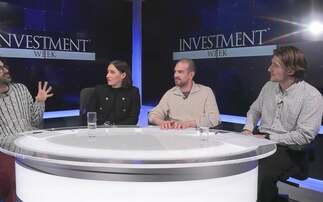
Key points
At Man GLG, we have the best of both worlds: best-in-class, highly skilled talent powered by quant-empowered, deep fundamental research. It’s a no brainer: Powerful data. Human edge.
Active management is a difficult business: not only is it hard to consistently generate persistent excess returns at scale, but it is also hard to unpick skill from luck. For allocators and recruiters, the tendency is to focus on outcomes - who hasn't been guilty of extrapolating a track record at some point?
But in a pursuit beset with so much noise, so many styles, and frankly the capacity for luck to contribute to perceptions of brilliance over an entire business cycle, focusing on outcomes is fraught with danger. In The Success Equation, Michael Mauboussin explains how powerful the narrative fallacy is in our reasoning: "The basic challenge is that we love stories and have a yearning to understand the relationship between cause and effect. As a result, statistical reasoning is hard, and we start to view the past as something that is inevitable."
Consider the spectacular, rapid asset gathering successes of some growth-orientated firms in the past two years through this lens: rates collapsed, long duration equities soared, and firms with all-encompassing house views that embraced this style were lauded as rare geniuses. But since the conditions that led to the furious rally in duration were inherently unforecastable, it is difficult to conclude that performance outcomes reflect skill.
At Man GLG, we have two overriding principles in hiring and supervising portfolio managers: 1) we have no house view - portfolio managers are free to execute their strategies as they see fit within pre-agreed risk limits; and 2) we try to judge skill from processes, rather than fixate on outcomes. We do the former because we are acutely aware that styles come and go, that the best managers design processes that are consistent with their personality types, and that what works for one does not work for another. We do the latter because, frankly, it gives us an edge in hiring, producing returns, and satisfying the itch of those keenest to improve.
Why Measure Skill?
A primary goal of measuring skill is to provide hard, quantitative feedback to portfolio managers to help them understand what works for them, and develop and hone their investment process.
Let us make an unnatural comparison here and take archery as an example. Once a bowman shoots his arrow at his target, the ‘feedback' he gets is almost instantaneous: he knows whether he's close to the target or not. This can allow the archer to change his position, tilt the bow, aim higher or lower, etc, to get to the desired result.
Unfortunately, feedback from financial markets often come in a highly distorted and untimely manner. Once a manager initiates a position, she doesn't instantaneously know whether it was a good or bad decision - factors such as market movements, ‘noise' from competitors and behavioural and unconscious biases all muddy the feedback.
This can potentially reinforce long-term suboptimal behaviours. As such, we believe it's important that portfolio managers are provided with effective data-supported feedback to counteract anecdotal evidence that can be given too much credence by either its recency or emotional intensity.
Measuring Skill
Good portfolio managers embrace philosophies that are consistent with their cognitive and behavioural processes, and these may differ materially from one highly skilled team to another.
There are four main ways to customise these skill metrics:
- Choose an appropriate benchmark
Typically, about 30-50% of a stock position's return is explained by movements in the market. Being able to isolate a position's return due to skill as opposed to due to market movements is therefore key. As such, it is important to choose an appropriate benchmark so that the longs and shorts can be examined. Otherwise, all the longs would look great in a bull market, while all the shorts would look terrible.
- Understand the investment process
Next, to understand the core investment process, the average holding period and what constitutes a meaningfully sized position for each portfolio manager should be considered. It may also be worth sub-selecting the measures that are aligned with the manager's intentions; for example, if trading earnings announcements are a core part of investment process, then those measures should be brought to the fore.
- Assess investment activity
Though it may sound obvious, we believe a manager's two primary activities - initiating or increasing positions, as well as closing or decreasing positions - should be measured.
Although these activities - buying and shorting - seem like two sides of the same coin, there are usually quite distinct behaviours and skill levels between the two, primarily driven by the differing levels of attention and purpose behind the trading.
Another reason to assess investment activity is to measure the alpha decay: because of biases, portfolio managers may stay in a ‘long' position or keep holding onto their shorts for too long.
- Compare with counterfactuals
To make the insights stronger and more concrete, and to enable recommendations being made to portfolio managers, we believe it is important to present counterfactuals, where simple transformations to a portfolio such as a stop loss rule or equal sizing positions are mechanically applied.
Comparing the counterfactual portfolios to the actual portfolios helps the manager understand, for example, how much value their sizing decisions have contributed and how consistent that value has been through time.
Share the Findings, Recommendations and Feedback
Once the metrics have been assembled, the next critical step is presenting the data back to the managers.
When holding up the quantitative mirror to a portfolio manager, a good proportion of the insights shouldn't really be a surprise; after all, part of being a successful manager is being very self-aware. These confirmatory insights help the manager build confidence in their process while other revelatory aspects can become lively topics of discussion, which is likely to trigger a bespoke piece of research.
For elite competition, where success or failure often comes down to the barest of margins, focusing on incremental improvements makes an enormous amount of sense: taking each part of a process and doing things a little better can compound up to make material differences in outcomes.
Hypothetical Results
Hypothetical Results are calculated in hindsight, invariably show positive rates of return, and are subject to various modelling assumptions, statistical variances and interpretational differences. No representation is made as to the reasonableness or accuracy of the calculations or assumptions made or that all assumptions used in achieving the results have been utilized equally or appropriately, or that other assumptions should not have been used or would have been more accurate or representative. Changes in the assumptions would have a material impact on the Hypothetical Results and other statistical information based on the Hypothetical Results.
The Hypothetical Results have other inherent limitations, some of which are described below. They do not involve financial risk or reflect actual trading by an Investment Product, and therefore do not reflect the impact that economic and market factors, including concentration, lack of liquidity or market disruptions, regulatory (including tax) and other conditions then in existence may have on investment decisions for an Investment Product.
In addition, the ability to withstand losses or to adhere to a particular trading program in spite of trading losses are material points which can also adversely affect actual trading results. Since trades have not actually been executed, Hypothetical Results may have under or over compensated for the impact, if any, of certain market factors. There are frequently sharp differences between the Hypothetical Results and the actual results of an Investment Product. No assurance can be given that market, economic or other factors may not cause the Investment Manager to make modifications to the strategies over time. There also may be a material difference between the amount of an Investment Product's assets at any time and the amount of the assets assumed in the Hypothetical Results, which difference may have an impact on the management of an Investment Product. Hypothetical Results should not be relied on, and the results presented in no way reflect skill of the investment manager. A decision to invest in an Investment Product should not be based on the Hypothetical Results.
No representation is made that an Investment Product's performance would have been the same as the Hypothetical Results had an Investment Product been in existence during such time or that such investment strategy will be maintained substantially the same in the future; the Investment Manager may choose to implement changes to the strategies, make different investments or have an Investment Product invest in other investments not reflected in the Hypothetical Results or vice versa. To the extent there are any material differences between the Investment Manager's management of an Investment Product and the investment strategy as reflected in the Hypothetical Results, the Hypothetical Results will no longer be as representative, and their illustration value will decrease substantially. No representation is made that an Investment Product will or is likely to achieve its objectives or results comparable to those shown, including the Hypothetical Results, or will make any profit or will be able to avoid incurring substantial losses. Past performance is not indicative of future results and simulated results in no way reflect upon the manager's skill or ability.

This post is funded by Man Group












